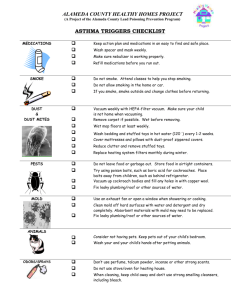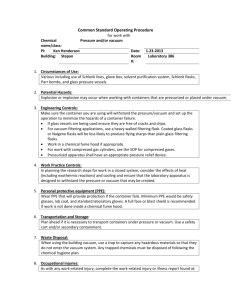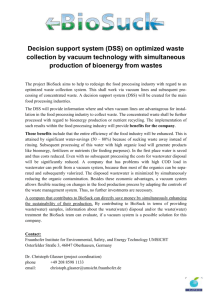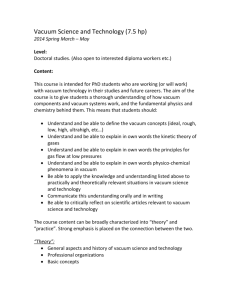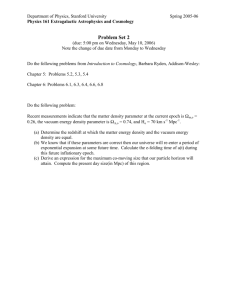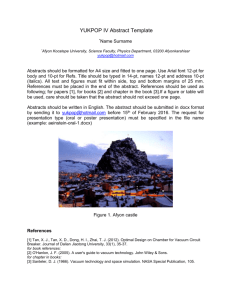Thermoforming Machines
advertisement
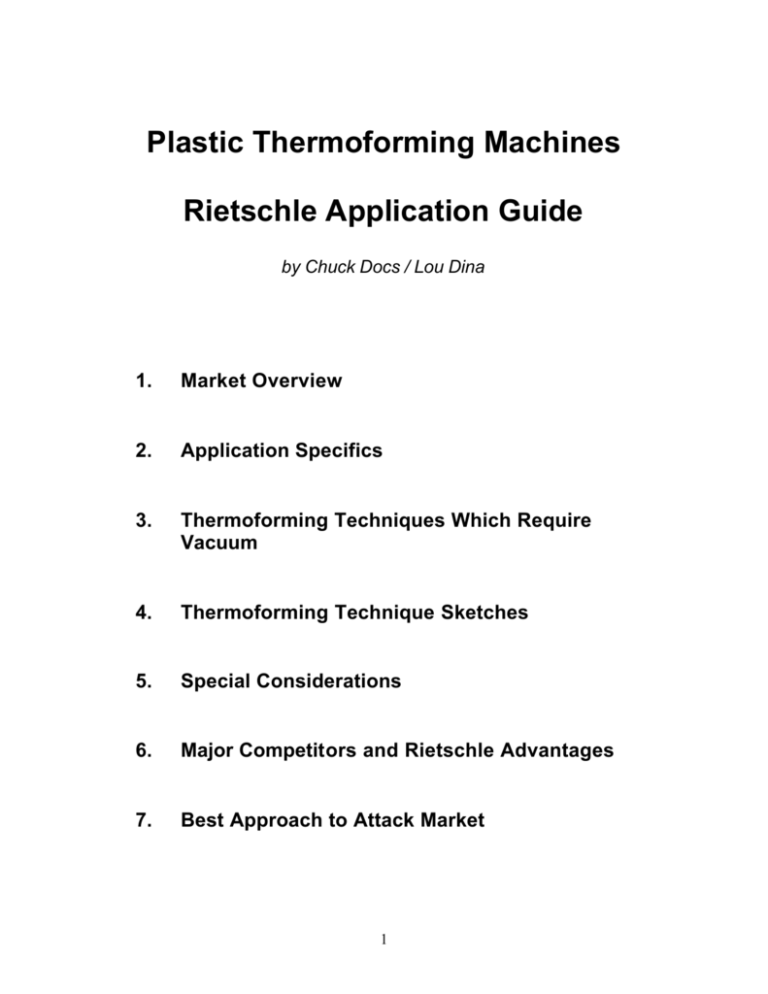
Plastic Thermoforming Machines
Rietschle Application Guide
by Chuck Docs / Lou Dina
1.
Market Overview
2.
Application Specifics
3.
Thermoforming Techniques Which Require
Vacuum
4.
Thermoforming Technique Sketches
5.
Special Considerations
6.
Major Competitors and Rietschle Advantages
7.
Best Approach to Attack Market
1
1.
Market Overview – Thermoforming Plastics
Thermoforming is a plastic fabricating process that involves heating sheet plastic and
forming it over a male or female mold. Thermoforming machines use pressure and/or
vacuum for forming the plastic in the molds. They also occasionally use blowers for trim
scrap collection as well as pick and place (suction cups) for feeding large cut sheets into
the machines. On web fed thermoformers, it is common to have the continuous sheet
extruder immediately attached to the thermoformer. Extruder applications requiring
vacuum are covered in a separate paper, but should be considered as a potential
opportunity as well.
Thermoformed plastic parts are the choice for many manufacturers due to lower tooling
and engineering costs, acceptably close tolerances, sharp detail and higher production
rates as compared to plastic injection molding. It is also an alternative to manufacturing
these parts from other materials, such as wood, glass, paper and metal.
Though the manufacturers of thermoforming machinery (O.E.M.’s) are the most
attractive market focus, end user applications are very broad and quite numerous.
Applications for thermoformed plastic products include: automotive interiors and
exteriors, sports and recreational equipment, boat and canoe manufacturers, skylights
and other home improvement items, bathtubs and shower stalls, disposable packaging,
drinking cups and storage containers, appliance panels a nd components, prepared food
packaging, bottle making, signs and point of sale displays, blister packaging, luggage
packaging, industrial supplies, medical supplies, cosmetics, electronics, etc.
Plastics that lend themselves best to thermoforming, and hence, may be beneficial to be
familiar with, include: acrylonitrile-butadiene-styrene copolymer (ABS), high-impact
polystyrene (HIPS), high density polyethylene (HDPE), polypropylene (PP), poly vinyl
chloride (PVC), thermoplastic rubber (TPR), polycarbonate (PC), thermoplastic
polyester (PETG) and polyetheretherketone (PEEK).
It is not unusual for the O.E.M. to supply a thermoformer without a vacuum pump, even
though it requires vacuum. In this case, the end user likely has a central vacuum
system. This too is an opportunity for Rietschle systems.
There are two basic types of thermoforming machines 1.) sheet-fed machines and 2.)
web-fed machines.
Sheet-fed machines are available in two styles 1.) Shuttle Machines and 2.) Rotary
Carousel. The vast majority of both machine styles require vacuum, and occasionally
positive pressure. Sheet fed machines can range in size, capable of forming sheets
from a couple square inches to greater than 10X20 foot sheets with up to 4 foot deep
molds.
Web fed machines are most commonly used for the disposable packaging markets,
using roll stock. Continuous sheets are typically between about 24” to 60” in width.
2
Common to either style thermoformer (sheet fed or web fed) are the forming techniques
used to produce the molded plastic products, described below.
2.
Application Specifics
Each thermoforming machine will have it’s own specific requirements. These
requirements are dependent upon the type of material being molded, the method of
heating required, the moldable material temperature which must be achieved, the
material thickness, whether the mold is male or female and whether the product
requires vacuum, pressure or a combination of both.
The following are typical vacuum levels required in the mold for various thicknesses of
plastic. Note that it is assumed the product is suitably heated to be moldable.
Thickness of Plastic
20 to 65 mils
66 to 100 mils
125 to 187 mils
188 to 250 mils
250 mills or greater
Usual “Instantaneous” Vacuum Levels Required
11-13”HgV
14-17”HgV
20-22” HgV
24-26” HgV
26”HgV+ & mechanical means
The vacuum system consists of a suitable vacuum pump, a vacuum reservoir,
inlet check valve, vacuum switches, motor starter, vacuum gauge, flexible
connector, shutoff valve, solenoid valve (one for each mold) and a manual
receiver drain. The sizing info below pertains to the vacuum pump capacity and also
the vacuum receiver tank volume.
Depending on the production speed of thermoformer, it is often necessary that a
vacuum reservoir be utilized to speed recovery time and insure the requirement for
instantaneous vacuum in the mold. The following equations can be used to calculate a
reservoir size, pump size and the recovery time between loads.
Assumptions and Definitions of Parameters:
V1 = forming volume, (i.e., the “void” space between the mold and the unformed
plastic that must be evacuated, measured in cubic feet)
V2 = the volume of the vacuum system reservoir (cubic feet)
V3 = the total volume (V1+V2) (cubic feet)
P1 = initial pressure in the mold (typically atmospheric or 29.92”HgA)
P2 = The ultimate system vacuum, (“HgA), is determined by the end user or OEM and
should be field adjustable through the relief valves, or other methods of vacuum
control.
3
P3 = the instantaneous vacuum, (or equalization vacuum), comes from the OEM, the
end user, or from the above chart, based on sheet thickness. (“HgA)
Instantaneous vacuum level will fall between the initial mold pressure, (P1,
which is usually atmospheric), and the maximum system vacuum, or P2.
CAP = Average capacity of pump between P3 & P2
ln = natural logarithmic function
THEORY FOR SELECTING VACUUM SYSTEMS
(Final formulas and Examples follow for those who wish to skip theory)
From the ideal gas laws, P1V1=P2V2, you can develop a formula for determining
the vacuum equalization pressure. When vacuum is applied to the product, it
immediately forms it's basic shape. It is not the vacuum that does the forming, but
atmospheric pressure that forces the heated pliable material into the mold. Once
vacuum is applied, the operating vacuum pump continues removing additional air,
thereby pulling a higher vacuum.
For example, assume 21"HgV instantaneous vacuum (equalization vacuum) is required.
After equalization pressure is achieved, (nearly instantaneously upon opening the
solenoid valve to the mold), the operating vacuum pump will continue to remove air from
the system, thus increasing the mold and reservoir vacuum to 26”HgV, 28"HgV or
higher. This completes the forming process and gives better detail to the end product.
The other parameter to consider is cycle time, or recovery time. This is specified by the
OEM or end user, and is generally a function of the maximum machine speed or human
ability to keep up with the machine.
Back to the ideal gas laws. P1V1 applies to the initial pressure and volume of the mold
and mold box. P2V2 applies to the vacuum system reservoir. P3V3 applies to the total
combined volume and the equalization pressure of the two combined. A solenoid valve
is installed between the mold box and the vacuum reservoir.
P1V1 + P2V2 = P3V3
and V1 + V2 = V3
substituting V1+V2 for V3 and solving for V2
V2=(P3V1-P1V1) / (P2 - P3)
P1 = the initial mold & mold box pressure (usually atmospheric pressure)
P2 = the ultimate 'vacuum system' vacuum level (in "HgA), which will typically be from 4
to 2"HgA (26 to 28"HgV). This is why the VACFOX line fits so well. P2 is the ultimate
system vacuum level that is maintained in the reservoir when the solenoid at the mold
and mold box closed. This level is set by vacuum switches or through a relief valve or
4
other method of vacuum level control. This is the highest pressure that will be achieved
in the mold. It is NOT the instantaneous vacuum. Remember, the instantaneous
vacuum level (or equalization vacuum level) will fall between the initial mold pressure
and the maximum system vacuum level when the valve is opened.
P3 = Equalization Vacuum = the vacuum level that occurs momentarily i n the mold
when the solenoid valve between the mold and the vacuum receiver is opened. After
the equalization vacuum (or instantaneous vacuum) is reached, the vacuum pump
continues to run. With both the vacuum reservoir and the mold now open to vacuum
pump, the entire system will see higher and higher vacuum levels over time, until the
ultimate system vacuum is approached or attained. The instantaneous vacuum level (or
equalization vacuum) is the vacuum level required to mold the heated sheet. The
thicker the sheet, the higher the vacuum needed, per the enclosed chart.
The TIME it takes to get from P3 back up to P2 is the Reservoir recovery time
and is dictated by the cycle time described above.
PRACTICAL STEPS TO SIZE AND SELECT THE VACUUM SYSTEM
The preceding was the theoretical back drop to correct sizing and selection of a vacuum
system for Thermoforming applications. Below are the actual formulas you will use to
select equipment, along with an example.
1.) DETERMINE THE RESERVOIR SIZE, USING THE REQUIRED VACUUM LEVEL
(for P3) AS DETERMINED BY THE PLASTIC THICKNESS (or as specified by end
user).
Volume of Receiver (in US gallons) = {[(V1) x (P3 – P1)]/(P2-P3)} x 7.48
2.)
DETERMINING THE INSTANTANEOUS VACUUM IN THE MOLD WHEN THE
RESERVOIR VOLUME IS KNOWN.
Instantaneous Vacuum (in “HgA) = [(P1 x V1) + (P2 x V2)] / (V1+V2)
3.)
RESERVOIR RECOVERY TIME
Recovery Time (in Minutes) = (V3 / CAP) x ln (P3 / P2)
By picking a pump with a different average capacity, or modifying the vacuum system
pressure or reservoir size, the recovery time that may be targeted could then be
achieved, and hence the pump size optimized. The broad and complete range of
Rietschle VACFOX models is ideal for this reason.
5
EXAMPLE:
Customer has a 15 cubic foot mold (6 cubic foot forming mold + 9 cubic foot mold box)
and is forming 0.187 inch thick material (187 mils). The material is suitably heated. The
customer is not sure what vacuum is required. Cycle time, per the customer, will be
about 45 seconds (0.75 minutes). What size reservoir size and vacuum pump is
required for this application? We use 28"HgV (2"HgA) for our system vacuum and
assume 22"HgV (8"HgA) as the instantaneous vacuum (from the chart).
Summary of Given Data
reservoir size = V2
P1=29.92"HgA
V1 = 15 cubic feet
P3 = Instantaneous Pressure = 8"HgA (22”HgV)
P2 = Ultimate System Pressure = 2"HgA (28”HgV)
1.) DETERMINE THE RESERVOIR SIZE, USING THE REQUIRED VACUUM LEVEL
(for P3) AS DETERMINED BY THE PLASTIC THICKNESS (or as specified by end
user).
V2 = Volume of Receiver (in US gallons)
V2 = {[(V1) x (P3 - P1)] / (P2 - P3) x 7.48}
V2 = {[(15) x (8 - 29.92)] / (2 - 8)} x 7.48}
V2 = 410 gallons (54.8 cubic feet)
(Choose a “standard” reservoir size - say 396 gallon)
V3 = Total System Volume (less piping)
V3 = V1 + V2 = 15 + 54.8 = 69.8 cubic feet
We have now achieved an equalization vacuum of 22”HgV, starting at the 28"HgV and
reaching at 22"HgV instantaneously when the valve is opened. Now, the customer
wants to return to the original 28"HgV vacuum in the reservoir (plus piping) within the 45
second (3/4 minute) specified cycle time so he is ready for the next forming cycle.
2) RESERVOIR RECOVERY TIME
Recovery Time (in Minutes) = (V3 / CAP) x ln (P3 / P2)
We know the time, but need pump capacity. Using the above Reservoir Recovery Time
formula, solve for CAP to choose a vacuum pump average capacity.
CAP = (V3 / t) x ln (P3 / P2).
CAP = (69.8 / 0.75) x ln (8 / 2)
CAP = 129 acfm average pumping speed (choose one Rietschle VACFOX series
VC-200, or two 50% Rietschle VCEH-100's)
(this is a relatively large system)
6
The problem can be approached another way, by assuming a reservoir size and
solving for the instantaneous vacuum level. Note that reservoirs come in standard sizes
rated in gallons (7.48 gallons per cubic foot).
Using the same problem, we can instead calculate the instantaneous vacuum assuming
we have a 396 gallon reservoir (53 cubic feet = V2)):
P1V1 + P2V2 = P3V3 (noting that V3 = V1 + V2, now 15 + 53 = 68)
P3 = {(29.92 x 15) + (2 x 53)} / 68
P3 = 8.16"HgA (or 21.76"HgV)
Calculating the time to recover to 2"HgA:
t = (V3 / CAP) x ln (P3 / P2)
t = (68 / 129) x ln (8.16 / 2)
t = 0.741 minutes to recover (44.46 seconds)
If the system has known leaks, it is recommended that a safety factor of up to 20% be
added. Anything greater than this would justify fixing the leaks versus supplying a
larger vacuum pump.
The economics and efficiencies of simplex, duplex and triplex SYSTEMS should
be considered.
General Comments on Sizing Systems
The intent of the above is to show a suitable method for sizing vacuum pumps and
receivers to adequately handle vacuum thermoforming requirements. Every machine
and every mold will have it's own personalities/requirements that can make it somewhat
unique . Still, the above sizing techniques are generally valid for most all types of
machines. It is recommended that the final decision be left to the machine builder
or end user's experience. Particularly, the combined vacuum level (P3) should be
determined by the OEM, end user, or through laboratory or field tests. If they cannot
make a determination, then the guidelines we supplied for the various vacuum ranges
for thickness plastics can be used. No safety factor is required, though if picking a P3,
taking the higher end of the range is recommended. In cases where the customer
insists that Rietschle select the system, obtain as much data as possible and forward it
to our Sales or Engineering Department in Hanover for proper handling.
Typical pump sizes range from the VACFOX VGD-10 through VC-600. Typically, it is
recommended that the pumps be duplexed, with either a 100% back-up, or with two
smaller units running together using a “lead/lag” vacuum switch to satisfy demand.
7
3.
Thermoforming Techniques Which Require Vacuum
and/or Air Pressure
The following descriptions will provide insight into some of the different techniques used
in Thermoforming, and will help you to identify where and when vacuum and/or air
pressure are required. Greater knowledge will increase your credibility with your
customer, help you to communicate better, and allow you to more thoroughly
understand his needs.
Refer to the corresponding diagrams in Section 4 for each of the following descriptions.
I.
Straight vacuum forming. The plastic sheet is clamped and heated. A vacuum
beneath the sheet (a) then causes atmospheric pressure to push the sheet down into
the mold. As the plastic contacts the mold (b), it cools. Those areas of the sheet
reaching the mold last are the thinnest, since they have been “stretched” the furthest.
(c).
II.
Drape forming. The plastic sheet is clamped and heated (a), then drawn over
the mold, either by pulling it over the mold or by forcing the mold into the sheet, thus
creating a seal (b). Vacuum applied beneath the mold further forces the sheet over the
male mold. By draping the sheet over the mold, that part of the sheet touching the mold
remains close to the original thickness of the sheet. Side walls are formed from the
material draped between the top edges of the mold and the bottom seal area at the
base. Final wall thickness distribution is shown in drawing (c).
III.
Pressure bubble-plug assist vacuum forming. After the plastic sheet is
heated and sealed across the female cavity (a), air is introduced into the mold cavity
and blows the sheet upward into a bubble, stretching it evenly (b). Normally an electric
photocell is used to control the height of bubble. A plug, shaped roughly to the contour
of the mold cavity, plunges into the plastic sheet (c). When the plug has reached its
lowest position, a vacuum is drawn on the cavity to complete formation of the sheet (d).
In some instances pressure forming air is also used in this process.
IV.
Vacuum snapback. After the plastic sheet is heated and sealed over the top of
the female vacuum box (a), a vacuum applied at the bottom of the vacuum box pulls the
plastic material into a concave shape (b). The latter can be controlled by turning
vacuum on and off to maintain a constant shape in the sheet. When the plastic has
been prestretched, the male plug enters the sheet (c) and a vacuum is drawn through
the male plug. Vacuum beneath the sheet is vented to the atmosphere or light air
pressure is applied in place of the vacuum. External deep draws (d) can be obtained
from the vacuum snapback process for forming items like luggage, auto parts, etc.
8
V.
Pressure bubble vacuum snapback. Once the heated plastic sheet is clamped
and sealed across the pressure box (a) controlled air pressure applied under the sheet
causes a large bubble to form. The sheet is pre-stretched about 35 to 40%. When it is
preformed to the desired height (b) a plug is forced into it (c) while air pressure beneath
the sheet remains constant. When the male plug closes on the pressure box, higher air
pressure beneath the sheet and vacuum behind the plug create a uniform draw.
VI.
Air-slip forming. Technique is similar in many ways to snapback forming, but
the method of creating a “pre-billow” is different. Sheet is clamped and sealed to the
top of a vertical walled chamber (a). Since air is trapped in the chamber, the pre-billow
is achieved by a pressure buildup between the sheet and the mold base as the mold
rises in the chamber (b) and (c). Mold table is gasketed at the edges to form a sliding
seal against the chamber wall. Upon completion of stroke, the space between the mold
and the sheet is evacuated (d) and the sheet is formed against the mold by differential
air pressure.
9
5. Special Considerations
Vacuum pumps and compressors should always be fitted with relief valves.
Note that most end users believe that higher vacuum levels always translate into better
the performance. This is often not the case as can be shown by reviewing the
equations presented earlier. Note that by changing the vacuum level of the vacuum
system from say 1 “HgA to 2”HgA to 3”HgA or so does not necessarily have a very
significant effect on reservoir sizing nor on the effect on recovery time. This may prove
significant in sizing and selecting a proper p ump size when considering the average
capacity between two vacuum levels (P2&P3). Demanding excessively high vacuum
levels or capacities may result in your end user or OEM purchasing equipment that is
larger and more costly than required. It is always advisable to work with the customer
to determine their “true” needs, then provide an adequate safety factor in terms of pump
capacity and maximum required vacuum levels. As certainty increases, safety factors
can be reduced, making possible a more attractively priced offering that reliably
performs as expected.
External inlet filtration should strongly be considered for applications where solids from
the molding process can be carried over into the pump.
There should almost always be an inlet check valve included to prevent back flow
through the pump.
For applications requiring very quick recovery and/or instantaneous vacuum, a vacuum
reservoir is needed. This is a perfect opportunity to offer a Rietschle packaged
SYSTEM. Our standard tank mounted, or stacked arrangements are typically sufficient.
These systems can then be can be simplexed, duplexed or more to meet the needs of
the user.
Our standard systems include a local control panel with vacuum switch, inlet filter,
check valve and other accessories. A relief valve may need to be added.
Exhaust vapor is often directed out doors or to some point of collection to minimize local
odors and possibly harmful vapors to the machine operators. Backpressure limitations
on the Rietschle pumps as stated in o ur published data should be reviewed and not
exceeded.
Motor classifications of TEFC are generally accepted, but this should be verified. Verify
voltage of end user’s installation as well.
As with any application, it is important to ask the right questions from your OEM or end
users. Cost, speed, back-up capability, space and other issues should be addressed.
10
6.
Major Competitors and Rietschle Advantages
The three major oil sealed rotary vane vacuum pump competitors we see in this Market
are Busch, Gast and Becker.
The Rietschle VACFOX series of pumps offers several advantages including:
• Lower noise levels as these pumps are typically installed near operators
• High cfm per horsepower, an efficient option to our competition
• Very competitive pricing
• Superior quality and reliability, especially compared to Gast
• Cool operation means longer life and higher reliability. Aluminum vanes are
incredibly durable and come with a 5 year warranty.
• The most complete line of pumps in the typically needed capacity range, making a
perfectly matched pump fit available for most applications
• Fast pump down and recovery times with a Rietschle supplied system including a
properly sized vacuum reservoir
• An engineered systems approach that we can offer to help end users consolidate
several competitors small pumps into a more efficient and reliable complete
Rietschle Central Vacuum System.
Occasionally, central systems will be Liquid Ring style pumps (Sihi, Traviani, Atlantic
Fluidics, Nash, Siemens). These systems require a constant supply of water
(sometimes into millions of gallons per year) and also create a waste stream that
requires treatment before sending it to sewer. A calculated cost of water and cost of
drain to sewer water for the customer will often help draw interest into upgrading to an
alternate technology, such as Rietschle’s VACFOX line.
Oil lubricated Screw Vacuum Pumps are also used occasionally for this application.
When vacuum pump sizes reach 20 HP, 25 HP or larger, oil flooded screws become
price competitive. However, they are very expensive to maintain, require significant oil
piping, huge air/oil separators, and are noisier than oil lubricated rotary vane vacuum
pumps.
11
7.
Best Approach to Attack This Market
Rietschle’s best fit into this market is our VACFOX series of rotary vane, oil-lubricated
vacuum pumps, as well as the complete packaged engineered systems we can offer.
Don’t forget to discuss our ability to provide trim scrap collection systems or our ability
to provide vacuum pumps and blowers to handle their pick & place requirements. In
fact, the width and breadth of our product line is one of our great strengths, and virtually
guarantees we can provide the exact right technology and pump size for a given
application. The customer need not compromise or fear being provided the wrong
technology to meet his needs when he calls on Rietschle.
Targeting OEM’s is the primary focus for this market. As vendors come out with new
designs, work closely with them to discover their existing challenges and meet their
quality, speed, noise, space and other design and commercial concerns. The technical
features of the VACFOX line coupled with competitive OEM pricing and our ability to
meet delivery demands from our large inventory are strong points. Blanket orders with
scheduled ship dates should be a goal not only for the secured long term order, but also
because they help us to forecast demand to insure that we will meet the customer’s
schedules. See our VACFOX presentations and information for more details on the
superiority of this product line over our competition.
At the end user level, you should focus on upgrading users with several small older
individual pumps into one or more centralized systems. Reasons to upgrade to central
systems include saving power, water (when liquid ring units are used), reducing
maintenance, reduced noise, and improved production speed and on-line availability.
Alternately, we can upgrade the existing competitive pumps to Rietschle by offering our
superior quality and efficiency at our competitive market prices.
SIC codes you should prospect in your Rietschle sales territory include, but are not
limited to: 3559-9923, 3565-0000, 5084-0905 for OEM’s and 3081-0100 and 3089-0613
for end users.
When the customer’s needs are thoroughly addressed, proper sizing and accessory
studies applied, a Rietschle supplied vacuum pump, compressor, blower or system will
provide a very efficient, long lasting, highly reliable, low maintenance source of the
necessary consistent vacuum for the thermoforming applications.
12
Thermoforming Machines
Irwin Magnum Thermoforming Machine
Irwin “Progressive” Thermoforming Machine
PVI Inc. Pneumatic Clamp
13
PVI Inc. Thermoforming Machine
Double-End Termoformer
14
Forming Large parts on Thermoforming Line
Brown Inc. Continuous Thermoformer
15

